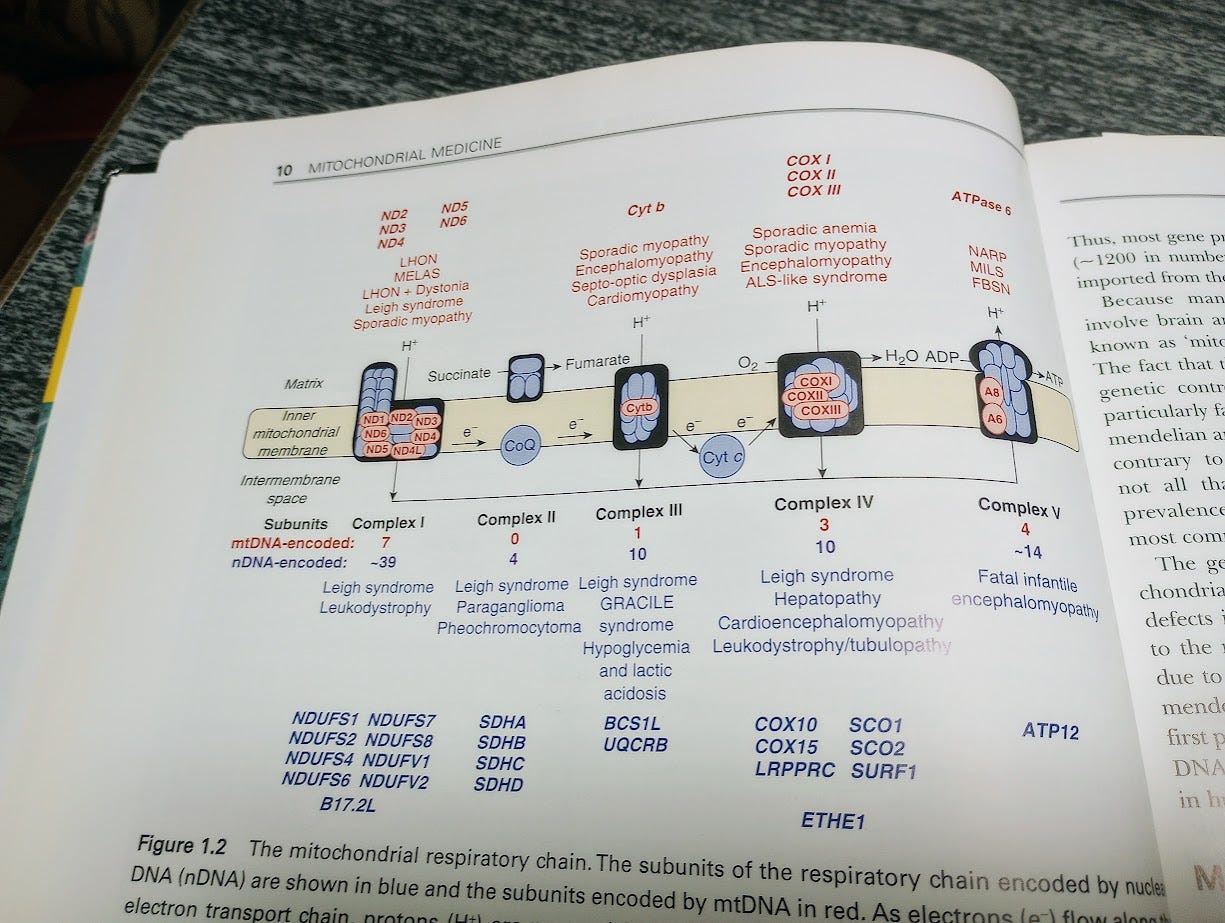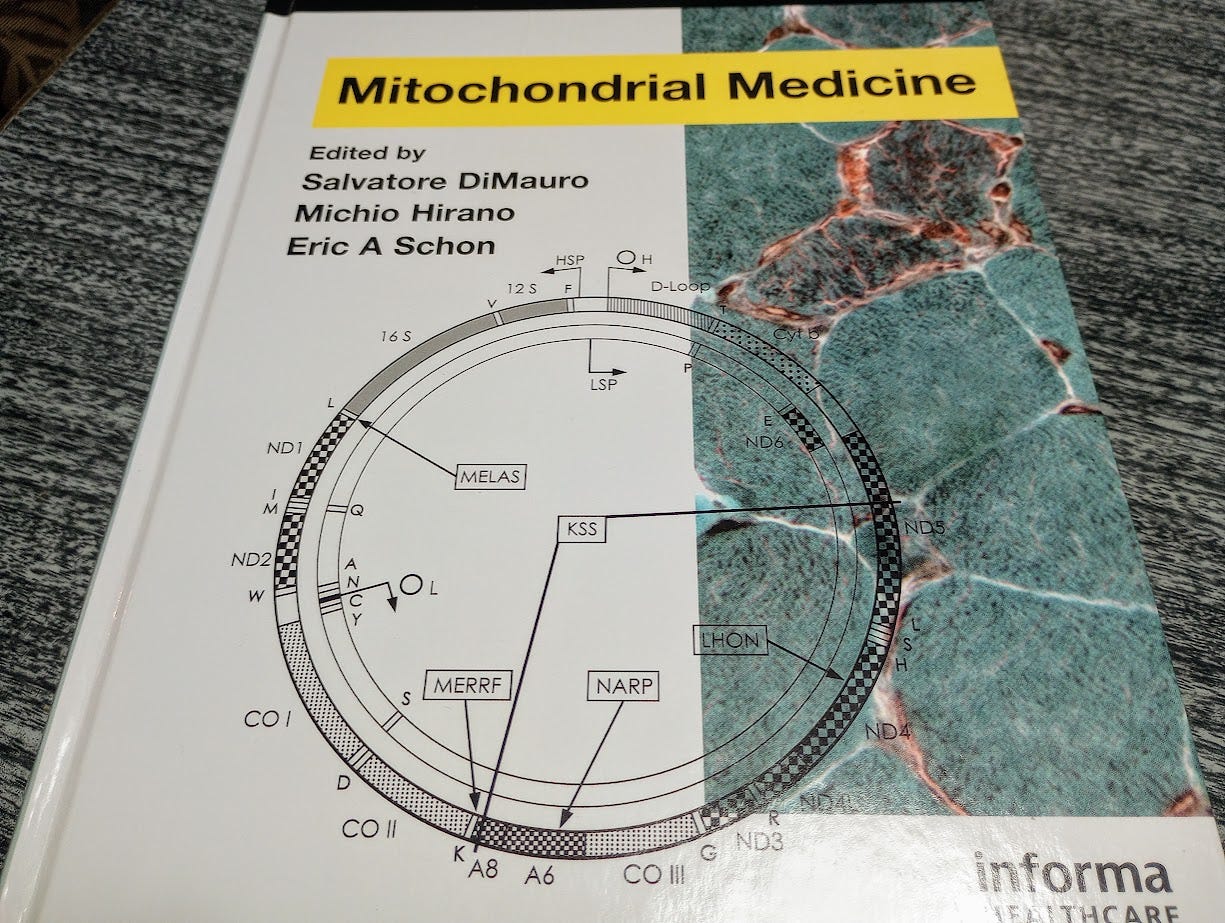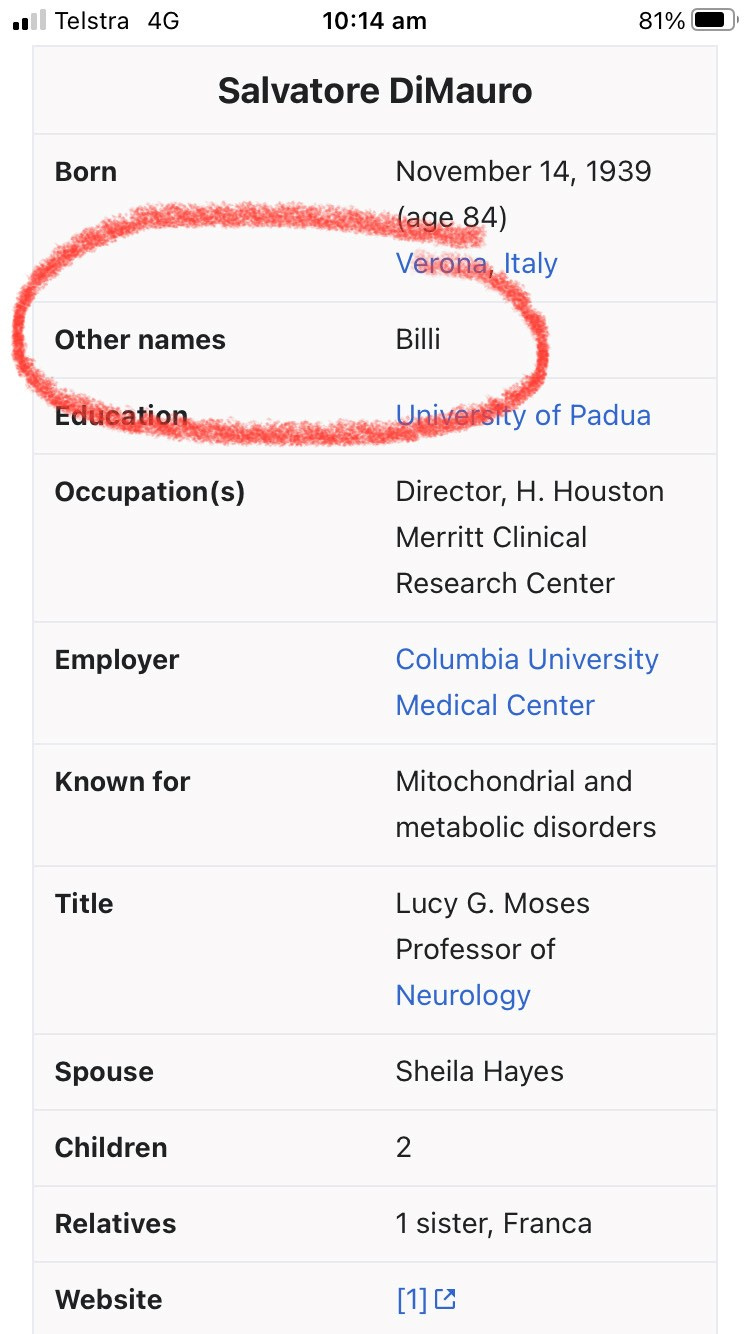Cancer involves cytoplasm and mitochondrial dysfunction of aerobic methylation; COX I and II vs COX 1 and 2 <- 26 letters in the alphabet are just enough.
Mitochondrial Medicine textbook - I bought it used and it is a signed copy! *Yes, I have been buying a lot of books, so I got myself a library card. So many books, so little time.
Personal health update re — Imaginary liver cancer (in my physician’s imagination, not mine) — it isn’t gallstones.
Personal update - there is something going on with my liver but I am feeling better since stopping Mucinex and use of animal products in my diet. I have also gotten better at drinking my glycine Cheerful juice by making a batch of mix to which I just need to add water and juice. I also reloaded my box supplements and have been better at taking them everyday. I am logging my daily routine with a simple paper system taped to a cupboard door.

The CT scan did not show any gallstones but did show an inch long area that might be a cyst or a tumor. The doctor wants an MRI and more blood was drawn for additional autoimmune labs.
The autoimmune labs turned out to be normal but my uric acid was slightly elevated. However I take 3000 mg of niacin per day, so that is not a mystery to me. My methyl folate and B12 were still elevated but also not a mystery. My supplements are high dose for those too - maybe too high dose for balance. That is a shopping issue though.
The doctor didn’t think salicylate excess would cause a cyst/tumor spot to be present. Drug toxicity would cause more diffuse liver inflammation. Thinking about that, led me to remember that salicylate excess inhibits methylation, so if I am already a poor methylator due to gene differences, than that could increase risk of cancer too. I am still leaning towards autoimmune disease over cancer. Gleep. Not fun to think about though.

I have been feeling better.
Misdiagnosis is not a fun thought either and is very common for autoimmune patients. The smooth muscle autoimmune antibodies were elevated and could be explained by my eating fish again, and a lot of it. An infomercial type of video has some valuable points to make about not identifying yourself with a diagnosis. You are more than an illness or assumed illness. Point two, believing that your symptoms are the enemy. Point three was to not have too much faith that a medication is all that is needed to ‘fix’ you. (BowenCollege.com) Too many medications are just symptom management that leads to other adverse symptoms and more diagnoses and more medications that have other side effects. That is a for-profit medical malpractice treadmill to hop off of as soon as recognize it.
I don’t want an MRI to better visualize a thing which would likely lead to being told that it still wasn’t clear enough to ‘see’, so a biopsy will be needed. A tissue biopsy could lead to other nosocomial infections or internal damage and might still be inconclusive. I went done that route with my father’s health issues. And why would I want to be on this treadmill if I don’t want any standard treatment for cancer?, or corticosteroids for autoimmune disease either? Monitoring some lab tests would be helpful but I don’t want to get an MRI just to please a doctor. I am not a 4 year old little girl who has to be good so that I might get a lollipop and a pat on the head.
Why focus on methylation cycle issues when considering cancer risk?
Because cancer involves a lack of methylation within the cell nucleus. In order for methylation to be able to occur within the cell nucleus, methylation cycles first have to be functioning correctly within the cell’s cytoplasm and within the cell’s mitochondria - or at least in enough of them to tip the cell toward functional methylation and away from lactic acid over-production. Lactic acid is produced when too many mitochondria in the cell are using anaerobic glycolysis instead of the aerobic Citric Acid Cycle. That can occur with gene dysfunction in mitochondrial genes or nuclear genes that are needed for mitochondrial function. It can also occur with nutrient deficiency or when a gene difference causes a back up somewhere in the interconnected methylation cycles.
When methylation isn’t happening within the cell nucleus, then genes that are normally kept in an inactive “off” position are no longer going to be in the “off” position. Cancer typically is an epigenetic problem - the methylation of genes is telling the gene to be “on” and ready to be transcribed into proteins, or “off” - closed for protein transcription. I started taking a Biology of Cancer class, and it is more like the Biology of Cancer as the for-profit medical malpractice industry understands it.
Tone and attitude about an issue can set up beliefs that may be inaccurate. The tone of cancer research suggests that cancer cells are purposely making changes specifically to harm and takeover the body - and that makes cancer cells a foreign invader to be fought. As I understand the role of the methylation cycle dysfunction and lack of epigenetic control by methylation - cancer growth is simply our own cells but now they are now are FULLY ON, making gobs of proteins, AND GROWING WITH NO STOPS! . . . because there is no methylation within the nucleus saying STOP to the genes that are being transcribed into rapid growth signaling proteins of some sort.
Sure we can spend many lifetimes looking at the minutia of which genes are part of rapid overgrowth of cancer - or we could spend a lot less time figuring out what needs to be fixed within a patient in order for their cells to be properly methylating within the cell nucleus again.
I don’t think I have liver cancer, but I do have some bad habits to work on, and I have methylation gene alleles that may increase my risk for developing cancer or other chronic health conditions. My use of dimethylglycine and other supplements would be protective - but only when I am using them instead of leaving them in the cupboard.
Lactic acid over-production - cancer and mitochondrial disorders are associated with lactic acidosis.
Lactic acidosis - inefficient methylation or inhibited methylation will need to more lactic acid production. More acidic urine leads to worse excretion of salicylate.
When the mitochondria can’t use the energy efficient Citric acid cycle/tricarboxylic acid cycle/Kreb’s cycle which uses oxygen, then the mitochondria switch to anaerobic, non-oxygen using glycolysis which creates more lactic acid waste and far less ATP, meaning less energy will be available to cells - and the human. A high fat or high saturated diet will also cause this switch to anaerobic energy production with increased lactic acid as a waste product.
Lactic acidosis is associated with mitochondrial disorders.
COX I and COX II inhibitors - signaling gases NO, CO, H(2)S, and HCN.
COX I and COX II inhibition would also negatively impact methylation cycles. They are two of the series of five protein complexes within mitochondria that are steps along the Citric Acid Cycle (Kreb’s cycle). (DiMauro, Hirano, Schon, 2006)
In the image below, the genes involved in the mitochondrial respiratory chain are shown with health conditions known to involve that gene. Gene dysfunction of cytochrome c oxidase, COX I, II, and III, in red, top row, are associated with Sporadic anemia, Sporadic myopathy, Encephalomyopathy, and ALS-Like Syndrome = fatigue and muscle weakness or inefficient nerve signaling to the muscles.
Mitochondrial trivia: In the image below, the genes listed in red are encoded by mitochondrial DNA (mtDNA) and the ones in blue are encoded by nuclear DNA (nDNA). COX I, II, and III are on the top line, in red, above Complex IV.

“The four gases, nitric oxide (NO), carbon monoxide (CO), hydrogen sulfide (H(2)S) and hydrogen cyanide (HCN) all readily inhibit oxygen consumption by mitochondrial cytochrome oxidase. This inhibition is responsible for much of their toxicity when they are applied externally to the body.” (Cooper, Brown, 2008)
That suggests that an overdose of COX I and II inhibitors chronically could lead to similar symptoms.
Carbon monoxide
Being a smoker means I am taking in carbon monoxide when I smoke (marijuana).
Sulfate sensitivity can lead to hydrogen sulfide accumulation.
Sulfur metabolism is also an issue for me that results in self-poisoning with hydrogen sulfide if I eat too many sulfur rich veggies, supplements, or Epsom salt/magnesium sulfate baths. I switched to magnesium chloride after realizing that I was sulfur sensitive (gene differences slow down my processing of it, so small amounts are okay but not large amounts, or chronically large amounts).
Nitric oxide can be over-produced during hyperinflammation.
Some health conditions can have too much nitric oxide production and others may have too little. Too much nitric oxide is produced during hyperinflammatory conditions systemically, and may also occur in localized areas of the body where endothelial tissue is damaged or in areas of atherosclerotic damage. (Stoclet, et al., 1998) So anything that was making me more inflamed was also likely leading to inhibition of COXI and COXII and adding to reduced methylation function.
“This happens in systemic inflammatory reactions like septic shock and in local reactions produced by endothelium denudation and atherosclerosis.” (Stoclet, et al., 1998)
COX1 and COX2 are different enzymes which salicylate excess would inhibit, or excess pomegranate peel or other phytonutrient antioxidants like quercetin, hesperidin and bromelain.
Salicylate excess and too much pomegranate peel and other potent phytonutrient products would be inhibiting cyclo-oxygenase enzyme, COX 1 and COX2. They are not the cytochrome c oxidase COX I, II, and III used in mitochondria. {I had to look into this for my own clarification.}
“Antioxidant COX-2 inhibitors exert radioprotection by inhibition of COX-2 activity and ROS scavenging activity. COX-2 inhibitors block prostaglandin synthesis by binding in the cyclooxygenase active site of COX-2.” (Laube, Kniess, Pietzsch, 2016)
“Cyclooxygenase (COX) first oxidizes arachidonic acid to prostaglandin G2 and then peroxidizes it to prostaglandin H2. COX exists as two isoforms: COX-1, which is constitutively active, and COX-2, which can be induced and mediates the inflammatory response.” Endocrine System, Robert G. Carroll PhD, in Elsevier's Integrated Physiology, 2007, viewable at (ScienceDirect/Cyclooxygenase)
Post: NSAIDs are COX1 and COX2 Inhibitors, while Antioxidants are COX2 Inhibitors, March 18, 2020.
Genetic differences can cause a life long need for high dose supplements of specific nutrients.
Plant phytonutrients can also help correct gene differences by modulating protein expression through regulation of microRNA. Both water and fat soluble phytonutrients can have that ability.
I have too many genetic oddities to be able to not use some high dose supplements. My methylation cycles need help without adding salicylate overload.
“Nutrition Enhancement’ was a phrase used in the Essential Oils Pocket guide to suggest that simply taking supplements is not the goal as much as providing the individual with the targeted nutrition that their own body needs - which can vary. Trial and error is the slow way to figure out what your body needs. A genetic screening can help but some trial and error will still be needed.
Trial and error: just try things and stop what seems to make you worse. Keep trying things until something seems to improve health, and then continue that.
And repeat as needed: Eliminate stuff and reintroduce things to see what seems to help or to not help. As we age — what used to work, may no longer be working.
Does cancer involve an intracellular infectious agent? or comorbid ones?
There has been some speculation about cancer being due to a pathogen or fungus of some sort. Why might anti-parasitic herbal medications help cancer too?
Answer: Any zinc ionophore can also be acting as an iron chelator and helping reduce oxidative stress within a cell which would add to mitochondrial dysfunction and less methylation within the cell nucleus for epigenetic control of what the cell does.
Cancer tends to exist in overly acidic bodies - overly full of oxidative stress chemical waste that needs to be buffered with antioxidants. If we aren’t making glutathione, then we won’t have enough antioxidants to clean up the oxidation.
The antifungal protocol using NAC, oregano essential oil, and pomegranate extract during a maintenance stage, might be useful for a variety of hyperinflammatory conditions including cancer. See this post: (denutrients/p/antifungal-nac-protocol-by-anons).
The mitochondria in a dysfunctional cell may be interpreted to be an “infection” that the body is producing inflammatory chemicals to fight. Fungus like bacterial Mycoplasmas also tend to grow in more excess when a person is unhealthy. And the archea mentioned in my other mitochondria book might be another intracellular pathogen. (post that mentioned archea; periodontal-gum-disease-linked-to-liver-disease)
We don’t know what we don’t know until we learn it.
In botany we sometimes see a tumorous growth form at the cut when cloning a plant (with added plant hormones) or excessive growth occurs when some species are cut. Buckthorn will sprout a huge amount of new branches from a cut stump. So why isn’t that type of out of control growth occurring all the time in plants? The plant hormones are kept in balance by cellular mechanisms that might include epigenetic control at the cell nucleus or control of microRNA by phytonutrients. (Epigenetic Regulation in Plants, Pikaard, Mittelsten Scheid, 2014)
“The prominence of epigenetic regulation in plants reflects their mode of development, lifestyle, and evolutionary history. Unlike growth in mammals, in which organ and tissue formation is largely specified during embryonic development, plants grow by continuously producing new organs from self-sustaining stem cell populations known as meristems. Consequently, postembryonic development in plants is a continuous process shaped by environmental influences resulting in a high degree of phenotypic plasticity. Because plants are unable to escape their surroundings, they are forced to cope with changeable and often unfavorable growth conditions. Epigenetic regulatory mechanisms can facilitate metastable changes in gene activity and fine-tune gene expression patterns, thus enabling plants to survive and reproduce successfully in unpredictable environments.” - Epigenetic Regulation in Plants, Pikaard, Mittelsten Scheid, 2014)
“phenotypic plasticity” ~ the ability of an organism to change how genes are being expressed so the resulting behavior/actions present a different phenotype than what the genotype might suggest would occur. “plasticity” in biology refers to changeability of something. Neuroplasticity is the ability for learned nerve pathways to be forgotten as new pathways are being used more often and the old pathways are being left largely unused. There is no need to drive to the old address or call the old phone number after it was changed, so the old address or phone number is gradually forgotten.
The plant can epigenetically turn on genes that might help in a drought and turn off genes needed during a flood and then change them back again as the weather shifts. We humans can do that too — when our cytoplasm, mitochondria and cell nucleus all have functioning methylation cycles that are using aerobic glycolysis, or aerobic metabolism of protein or fats. First the proteins or fats (or molecules of glucose) are converted into Acetyl CoA - but only if the person’s diet isn’t too high in total fat or saturated fat as that shifts metabolism to anaerobic pathways. This post discusses the role of acetyl CoA production in methylation cycles and how lack of it may precede cancer. (denutrients/p/nature-loves-a-good-design)
Without Acetyl CoA production, methylation cycles won’t be providing the nucleus with appropriate epigenetic control. Without epigenetic control of genes, then they all can be ON, and actively growing out of control - not because the cell is a “psychopathic cell” or is an evil cell with a planned intent to grow out of control because it is an alien force with goals to ruin your life — um, no. It is the salty, glutamate rich, fatty, sugary, and generally addictive modern foods and lifestyle that is ruining your life. »Reality check.
Essential oils are so fast and can be so effective because of the phytonutrients that can up or down regulate protein production based on what is happening in the cell fluid. The up or down regulation would be in order to reduce inflammation in whatever way the situation requires. Plants need to rapidly respond to the heat of a noonday sun, and then change again for a sudden drenching storm. Our job is to safely prepare and eat the plants. Yum!

Disclaimer: This information is being provided for educational purposes within the guidelines of Fair Use and is not intended to provide individual health care guidance.
Reference List
(Cooper, Brown, 2008) Cooper CE, Brown GC. The inhibition of mitochondrial cytochrome oxidase by the gases carbon monoxide, nitric oxide, hydrogen cyanide and hydrogen sulfide: chemical mechanism and physiological significance. J Bioenerg Biomembr. 2008 Oct;40(5):533-9. doi: 10.1007/s10863-008-9166-6. Epub 2008 Oct 7. PMID: 18839291. https://pubmed.ncbi.nlm.nih.gov/18839291/
(DiMauro, Hirano, Schon, 2006) DiMauro, S., Hirano, M., Schon, E.A., Mitochondrial Medicine, Informa Healthcare, 2006, https://www.routledge.com/Mitochondrial-Medicine/DiMauro-Hirano-Schon/p/book/9780367446369 I bought a used copy - and its signed! cool.

Addition - a reader figured out who Billi is - it is a nickname of the editor, Salvatore DiMauro. Thanks for sharing!
(Laube, Kniess, Pietzsch, 2016) Laube M, Kniess T, Pietzsch J. Development of Antioxidant COX-2 Inhibitors as Radioprotective Agents for Radiation Therapy-A Hypothesis-Driven Review. Antioxidants (Basel). 2016 Apr 19;5(2):14. doi: 10.3390/antiox5020014. PMID: 27104573; PMCID: PMC4931535. https://www.ncbi.nlm.nih.gov/pmc/articles/PMC4931535/
(Pikaard, Mittelsten Scheid, 2014), Pikaard CS, Mittelsten Scheid O. Epigenetic regulation in plants. Cold Spring Harb Perspect Biol. 2014 Dec 1;6(12):a019315. doi: 10.1101/cshperspect.a019315. PMID: 25452385; PMCID: PMC4292151. https://www.ncbi.nlm.nih.gov/pmc/articles/PMC4292151/
(Stoclet, et al., 1998) Stoclet JC, Muller B, Andriantsitohaina R, Kleschyov A. Overproduction of nitric oxide in pathophysiology of blood vessels. Biochemistry (Mosc). 1998 Jul;63(7):826-32. PMID: 9721335. https://pubmed.ncbi.nlm.nih.gov/9721335/







JD - Good to hear your doing better. At intermediate doses (1000mgd) Niacin will increase HDL cholesterol levels +15 to 30%.
HDL transports lipids to hepatic cells and the majority of HDL associated cholesterol is destined for biliary excretion. Cholesterol is excreted into the bile directly or after conversion to bile acids.
Higher niacin doses (3000 mgd) may cause jaundice, abdominal discomfort, blurred vision, worsening of hyperglycemia, and precipitation of preexisting gout.
As niacin overload can overwork the liver and result in hepatoxicity, people with a liver disorder probably should not take high dose niacin.
It may not be gallstones, but that pathway is tied in to whatever is going on viz. +niacin = +HDL = +bile & +uric acid
"Yes, I have been buying a lot of books, so I got myself a library card. So many books, so little time." Brought this to mind... https://youtu.be/UAxARJyaTEA?t=97